#DOMINIQUE PERRAULT
Photo

dc-tower one // wien donau-city
donau-city is one of the most interesting new development areas in vienna. the new high-rises dominate the city skyline from many points and also offer something different from the omnipresent k.u.k. architecture.
the architecture of the dc tower 1 looks like an obsidian wedge or a spaceship that has landed on the planet austria.
architects: dominique perrault & hoffmann-janz architekten
completion: 2013
film: ilford hp5 plus
camera: canon a-1 with canon fd 28m
#donau city wien#vienna#austria#ilford#iilford hp5#canon a1#analog#monochrome#black and white photography#modern architecture#dominique perrault#hoffmann janz architecten#dc tower one#architecture#photography#architecture photography#urban#urban photography#danube river
19 notes
·
View notes
Photo

P. Paris, France - 0123 BnF François-Mitterrand
#photography#lens#camera#travel#explore#discover#scenic#scenery#looking up#facade#building#architecture#modern architecture#reflections#library#dominique perrault#paris#france
9 notes
·
View notes
Text
BIBLIOTECA NACIONAL DE FRANCIA

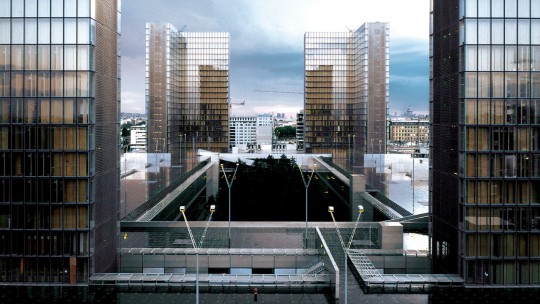
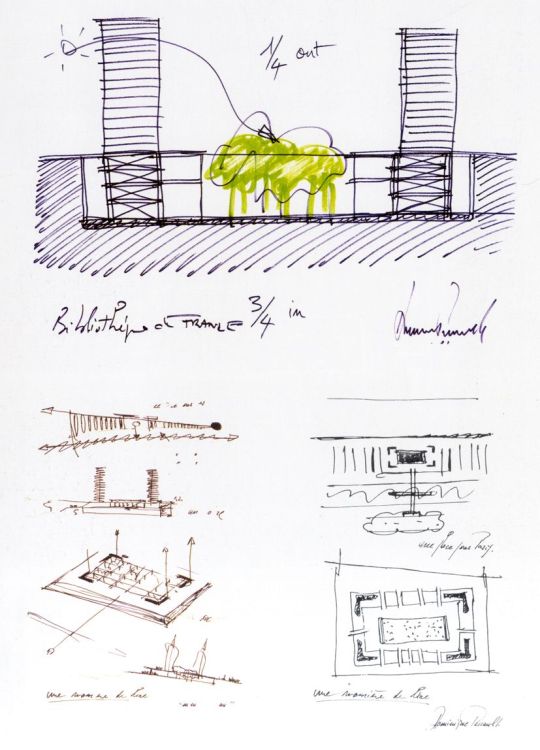
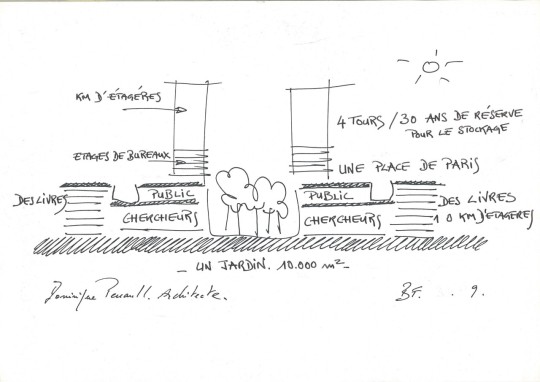


Arquitecto: Dominique Perrault
Ubicación: Paris, Francia
cronología: 1989 - 1995
Alumnas: Lucia Heredia y Sofía Aguilar
Dominique Perrault
Dominique Perrault es un arquitecto francés nacido en Clermont-Ferrand, Auvernia en 1953. Se hizo mundialmente conocido por el diseño de la Biblioteca Nacional de Francia, distinguido con varios premios a lo largo de su carrera. En 1981 crea el estudio Dominique Perrault Architecture, en Paris, desempeñándose entre 1982 y 1984. Dominique está comprometido con la arquitectura contemporánea., es profesor de la Escuela Politécnica Federal de Lausanne, conferenciante en Francia y en el extranjero y miembro del Consejo científico del Atelier Internacional del Gran París desde 2012. Es autor entre otras realizaciones del velódromo y de la piscina olímpica de Berlín; su obra se expone en los principales museos del mundo. El Centro Georges Pompidou de París le consagró una exposición monográfica sobre el conjunto de su trabajo en 2008.
Además fue designado comisario del pabellón francés de la sección de arquitectura de la Bienal de Venecia en 2010.En paralelo, está al frente de importantes operaciones de rehabilitación patrimonial. En la primavera de 2014, Dominique Perrault ha inaugurado la torre más alta de Viena, icono del nuevo barrio de negocios de la capital austriaca, así como el Gran Teatro de Cordeliers en Albi (Francia) y además, también tiene un posgrado en Urbanismo de la Escuela Superior de Puentes y Caminos e Historia de la Escuela de Estudios Avanzados en Ciencias Sociales.
Obra
La Biblioteca Nacional de Francia es la biblioteca más importante de Francia y una de las más antiguas del mundo, está situada principalmente en París.1 Sus actividades se reparten entre diferentes ubicaciones, siendo la principal la sede François Mitterrand en el XIII distrito de París, en la orilla sur del río Sena. Dispone de millones de volúmenes, y almacena otros recursos a través de otros departamentos como su biblioteca digital, Gallica.
Un decreto del año 1537, que sigue aún en vigor, exige que la BnF guarde un ejemplar de todas las obras publicadas en el país. Actualmente, alberga en total más de 13 000 000 de libros y 350 000 volúmenes encuadernados de manuscritos, además de colecciones de mapas, monedas, documentos, estampas y registros sonoros. Cuenta con catorce departamentos y numerosas colecciones principalmente conservadas en sus cuatro sedes parisinas, incluyendo el Departamento de monedas, medallas y antigüedades, heredero del Gabinete de Medallas. El conjunto de las colecciones representa alrededor de 4 000 000 000 de documentos impresos y especializados.
“Este proyecto es una pieza de arte urbano, una instalación minimalista donde los objetos y sus materias no son nada sin la luz que les transciende. Magia absoluta de la difracción de la luz a través de los prismas cristalinos. Naturaleza inesperada donde en el jardín solo se observa la frondosidad de los árboles. Un halo de luz, que nace del jardín y del corredor de servicio engarzará la BnF. Propagación de una luz diáfana en el interior de las torres de vidrio, para alcanzar los puntos culminantes que centellearán cual cuatro faros. Esta luz líquida se difuminará por la plaza mientras que las torres de reflejarán en el Sena” – Dominique Perrault
La BnF tiene como misión recopilar, catalogar, preservar, enriquecer y comunicar el patrimonio documental nacional; garantiza el acceso al mayor número de colecciones in situ, a distancia y desarrolla la cooperación nacional e internacional
Contexto Historico
Esta primero se llamó Biblioteca Real, después Biblioteca de la Nación y finalmente Biblioteca nacional, la Bibliothèque nationale de France (BnF), así desde 1994. Heredera de las colecciones reales constituidas desde finales de la Edad Media, es una de las más antiguas instituciones culturales francesas.
Una biblioteca con una gran historia, entres los reyes y los sabios, la apertura al público…
El nacimiento de la BnF, se enfrenta a esas dificultades por el crecimiento de la producción impresa y de la demanda cultural. Esta ocurre en un momento en el que los avances científicos y técnicos abren nuevas opciones para resolver esos problemas, tanto en la conservación como en el acceso a los documentos.
Las nuevas tecnologías actualizan los recursos para gestionar y localizar las colecciones. Digitalizando los textos y las imágenes, esto ayuda en las tareas de investigación y lectura, y abren la posibilidad de consultar documentos a distancia.
El lugar elegido para construir la biblioteca se encuentra junto al Sena, en el distrito XIII de París. En agosto de 1989, el proyecto del arquitecto Dominique Perrault es escogido por el presidente de la República tras superar un proceso de selección con un jurado internacional. Jack Langen ese momento ministro de Cultura, anuncia que transferirán al edificio todos los impresos de la Biblioteca Nacional.
Referencias:
Architecture, D. P. (s. f.). Dominique Perrault Architecture - BIBLIOTECA NACIONAL DE FRANCIA. ©2011 Dominique Perrault Architecture. Recuperado 25 de octubre de 2022, de https://www.perraultarchitecture.com/es/projectos/2465-iblioteca_nacional_de_francia.html
Historia de la Bibliothèque nationale de France. (s. f.). BnF - Site institutionnel. Recuperado 25 de octubre de 2022, de https://www.bnf.fr/es/historia-de-la-bibliotheque-nationale-de-france Colaboradores de Wikipedia. (2022b, octubre 16). Biblioteca Nacional de Francia. Wikipedia, la enciclopedia libre. https://es.wikipedia.org/wiki/Biblioteca_Nacional_de_Francia
3 notes
·
View notes
Quote
L’Europe est le nom de notre tradition, un murmure des temps anciens et du futur. Notre tradition est une façon de se conduire et de conduire notre vie qui n’appartient qu’à nous. Elle nous est révélée par les poèmes d’Homère et par nos grandes légendes, celles de la Table Ronde ou des Nibelungen. Elle nous est révélée aussi par le trésor des contes. Sous des apparences différentes, nos contes tissent la trame d’un même héritage de part et d’autre du Rhin, des Alpes et des Pyrénées. Retrouvés en Allemagne par les frères Grimm et en France par Charles Perrault, sans avoir l’air de rien, ils sont l’un de nos biens les plus précieux. Ils ne se voilent d’obscurité que si l’on ne fait pas l’effort de les découvrir. Jadis, leur transmission se faisait à la veillée, par le récit des Anciens. Se jouant du temps qui passe, ils continuent de dire le retrait salvateur dans la forêt, les forces de la nature, la solitude et la communauté, les rites de passage de l’enfance à l’âge adulte, la rencontre de la jeune fille et du chevalier, l’ordre du monde. Les contes sont le grand livre de notre tradition. Leur fonction est de léguer la sagesse ancestrale de la communauté. Même quand on y rencontre des elfes ou des fées auprès des sources et au coin des bois, ils sont le contraire des « contes de fées ». Sous l’apparence du divertissement, ils enseignent des leçons de vie. Ils disent les secrets qui feront que les demoiselles deviendront femmes et les garçons des hommes. Les contes disent les menaces à surmonter (le Chat botté), les limites à ne pas franchir (Barbe bleue), la ruse terrassant la force brutale (le Petit Poucet), la rançon de l’étourderie (le Petit Chaperon Rouge), le prix du serment (Grisélidis), l’effort soutenu triomphant d’une nature ingrate (Riquet à la houppe), les périls courus par la jeune fille et la virilité dévoyée (Peau d’âne). Les contes disent encore le courage, l’espoir et la constance des jeunes filles triomphant des épreuves (Cendrillon). Ils disent aussi la vigueur, l’audace, la vaillance et les ruptures par quoi les garçons sont ce qu’ils sont (Perceval). Les contes montrent qu’en s’appuyant sur les forces de la nature, la femme maintient ou restaure l’ordre du monde et de la communauté (Blanche Neige). Ces secrets sont nôtres, on pourrait parfois les croire perdus alors qu’ils ne sont qu’assoupis. Comme dans le conte de la Belle au bois dormant, ils se réveilleront. Ils se réveilleront sous l’ardeur de l’amour que nous leur porterons.
Dominique Venner, Histoire et tradition des Européens
#citation#littérature française#auteur français#quote#french literature#french author#dominique venner#histoire et tradition des européens
20 notes
·
View notes
Text
As you might have noticed with my latest post, I have been looking into Frau Holle recently. And I just read an article by Dominique Peyrache-Leborgne which has some interesting points.
The article starts out by pointing out the difficulty of translating "Frau Holle", the very name of the tale/entity, in French. "Frau" can become easily "Madame" or "Dame", Miss or Lady, no problem... But what about "Holle"? The very name is a part of German folklore - and not just German folklore, a very specific regional folklore in Germany around Hesse - and as such it means nothing to a French audience. Not only that, but since French is a Latin-derived language, unlike German, the very name "Holle" does not bear any connotations, implications or echoes in French the same way it does in German or even English. As such, while there were translations as "Madame Hollé" as early as 1869, the idea of keeping "Frau Holle" as "Frau Holle" or just transliterating as "Lady Holle" is quite recent - and only applies to scholarly translations. Meanwhile, for older or more "common" translations, a specific trend appeared in France, a translation-tradition that still lasts to this day. Translating Frau Holle as "Madame la Neige" (Miss Snow), "Dame Hiver" (Lady Winter) or other cold-related names.
An habit that the author of the article severely criticizes, because while indeed snow plays an important part in the fairytale, Frau Holle is not supposed to be a spirit of winter or an embodiment of the snow - or at least she does not appear exclusively as such. Frau Holle is a very complex cultural figure with various functions and appearances.
To help the audience understand the complexity of Frau Holle, the article presents in a simplified and summarized version the list of supernatural beings that appear in variations of the "Frau Holle" tale around the world - a list extracted from a work by Warren E. Roberts, a "very complete synthesis" called "The Tale of the Kind and Unkind Girls" (1958). To highlight this intertextuality not only helps understand the various roles and elements surrounding the "part" Frau Holle is supposed to play ; while also proving how Frau Holle synthetizes all of those various aspects together.
In most fairytales of the type "The Kind and Unkind Girls", the supernatural being is a female entity of magic. For example, a fairy - fairies are very recurring in this type of fairytale though, unlike in Perrault's famous "Diamonds and Toads", there is never just one fairy, they are always three. It is exemplified by Basile's "The Three Fairies" in his Pentamerone ; they also appear within several Judeo-Spanish fairytales of the Balkans (there was a recent anthology of them translated in French published by the José Corti edition), and it is quite common for these three fairies to be washer-women, or at least tied to water/rivers (several variations in the French region of Gascogne have the fairies as washer-women by the river). There is also an equally important number of fairytales, among these "female tales", where the girls rather deal with witches - characters that very easily replace or are confused with fairies in folktales. The most famous of those witches tale is the one Afanassiev called simply "The Baba Yaga", and where the famous Russian witch plays the part of Frau Holle. A third option also exists for the female magical being: just "an old woman", "little old woman", who is clearly magic but never called by any specific name like "fairy" or "witch" (this type of character, the "magical old woman", not quite a fairy not quite a witch, is very common among the Grimm fairytales). The "simple old woman" appears for example in another one of Basile's tales "The two little pizzas", and in a Bulgarian fairytale "Girl of gold, girl of ashes" (a story which did reach France through the Père Castor collection for children). Sometimes the old woman will ask to have lice removed from her head (for example in Greek fairytales). Finally, in lands with a strong Catholic presence, of course, the female supernatural entity is replaced by the Virgin Mary - something very common among Christianized fairytales, where the Virgin Mary plays the part of every positive female magical character (an example is the Spanish fairytale "Three Balls of Gold").
So we have here a quite coherent group of female entities, though quite ambiguous, the fairy-witch group. There is also a share of those stories that have male characters as the supernatural entity. Usually these are earthly entities tied somehow to nature: in the Ludwig Bechstein's "Golden Mary, Sticky Mary", it is a "wild man" or "savage man", the "Thürschemann" ; in Afanassiev's The Old Grumpy Woman it is a leshy, a male "forest spirit" ; and in Grimm's own "The Three Little Men of the Forest" it is, as the title says, three dwarves living in the woods. When it comes to the male stories, having them be a specific entity related to the weather or the flow of time similar to Frau Holle is quite common: in England you have Jack Frost, in Russia Grandfather Frost ; and in many European fairytales the supernatural group of men embodies either the four seasons or the twelve months (Basile's "The Months" for example ; the article also notes a 1996 French children book "Adeline, Adelune et le feu des saisons", Adeline, Adelune and the fire of the seasons).
Finally, there is also a set of tales with more enigmatic and mysterioues entities, whose roots seem to belong in myths, religious symbolism or magical rituals. For example in the Anglo-Saxon and Celtic traditions, the entity is usually three disembodied heads within a well, that asked for their hair to be brushed, or simply to be treated with respect. Miranda Jane Green evoked this trope within her "Celtic Myths", and James Orchard Halliweel collected a version of it, "The Three Heads in the Well" for his "Popular Rhymes and Nursery Tales of England".
And Frau Holle, as an old and ancient avatar of a lost Germanic goddess, manages to compile and regroup all of those aspects and all those various entities within her. Like the three heads in the well, she is associated with ancient myths and the world of the dead. Like the four seasons, the twelve months, and Jack/Grandfather Frost, she is a spirit of the weather and the cycle of time. Like the wild-men and forest-spirits, she is an entity of wilderness and nature (the Brothers Grimm, in their "German Legends", do note several times that she leads a "Wild Hunt" throughout the forest). And finally she is the ultimately fairy-witch ; she is the kind and benevolent wise woman... and the terrifying ogress-like long-teethed hag.
A complexity of character, a multiplicity of faces, that is retranscribed within the ungoing debate surrounding the etymology of "Holle". For those who want to study the German fairytales under a mythological angle (Jacob Grimm was one of the most famous names to do so, more recently Eugen Rewermann, a religion specialist, took back the Grimm theory), Holle is survivance of the old pagan goddess of Germany Hulda, a mother-earth goddess (hence why Frau Holle lives underground, down a well). This is notably this analysis that led Lucie Crane, the woman that translated the Grimm fairytales for the edition illustrated by Walter Crane, to translate "Frau Holle" as "Mother Hulda": it was an attempt to give back to her a mythological glory. But other scholars have argued that Frau Holle could also be a female version of this Norse winter-god associated with the dead that appears in the Eddas: Uller/Holler. Another analysis, that is tied to the fairytale, is the homonimy between "Frau Holle" and "die Hölle" - which is "Hell" of course, but since here Frau Holle rules over a benevolet underground "land of the dead", we can think of it as a generic term for the "Underworld" (the same way for example in some languages the Greek Underworld are referred to as "Hell" despite having the paradise of the Elysian Fields). And more so: "Holle" coul also be... "die Holde", which means kindness or benevolence.
Many, many possible readings all true in their own way, which not only testifies to the cultural wealth behind the figure of Frau Holle, but also reflects perfectly how the character is one of paradoxes, duality and multiplicites. Frau Holle is so powerful that she mixes the up and the down - her realm is underground and yet in it she makes it snow in the sky, as a goddess both chthonian and celestial... With Frau Holle, life and death becomes a blur ; and more importantly Frau Holle gathers within her all seasons, because she might make it snow like in winter, her domain is stilled filled with the fresh flowers of spring and the hot sun of summer...
[The author of the article did praise greatly John Warren Stewig's decision of translating the character's name as "Mother Holly" in 2001. "Holly" is close enough to "Holle" in sonority, but it also makes the character feel more familiar to an English-speaking audience since it is a quite common name ; and "Holly" also plays cleverly on both "holly", the plant, one of the defining symbols of winter, and "holy", evoking Frau Holle's alternate roles as a saint or a goddess]
#frau holle#grimm fairytales#mother holle#brothers grimm#mother holly#german fairytales#the kind and unkind girls#fairytale type#fairytale comparisons#supernatural beings#supernatural beings in fairytales#lady winter#mother hulda#european fairytales#mother winter
14 notes
·
View notes
Text


JANE BIRKIN CONCERT OH PARDON TU DORMAIS BY FRIENDS
A l’Olympia le 3 février 24
Les bénéfices de ce concert seront reversés aux restos du coeur.
Avec:
Dominique A, Fanny Ardant, Yvan Attal, Carla Bruni, Jarvis Cocker, Marion Cotillard, Etienne Daho, Lou Doillon, Thomas Dutronc, Charlotte Gainsbourg, Beth Gibbons, Arthur H, Keren Ann, Sandrine Kiberlain, M, Abd Al Malik, Mickey 3D, Miossec, Catherine Ringer, Vanessa Paradis, Eddy de Pretto.
Direction musicale et arrangements : Jean-Louis Piérot
Basse: Marcelo Giuliani
Piano et guitare: Jean-Louis Piérot
Guitare: François Poggio
Batterie: Colin Russeil
Photos: Thomas Perrault
7 notes
·
View notes
Text
100 Conferences
Belém Lima
Luisa Penha
Rui Neto
Bartolomeu costa Cabral
João Paulo rapagão
Cristina Guedes
Carlos Castanheira
Jean Pierre Porcher
Troy Howie
João Pedro Serôdio
Gil PitA Penumbra
Carlos Lobo
João Mendes Ribeiro
MVCC
Alexandre Alves Costa
Francisco Providência
Zalraa zawcwi
Nuno Senos
Arquitectos anónimos
Eduardo Aires
Andre Tavares
Go Hasegawa
Jean phillipe Vassal
Manuel Graça Dias
ESM
Nadia Tolonikva
Sou Fujimoto
Frances Kéré
Maurizio Lanzarato
Santiago Cirugeda
Eva Franch
Ali cherri
Pankay Mishra
Hans Ulrich Obrist
Kazuo Sejima
Guido Beltrami
Josep Quetglas
Inês Lobo
Nuno Brandão Costa
Made in
Nieto Sobrejano
Dominique Perrault
ESM
Camilo Rebelo
Tony Fretton
Roger Diener
Go hasengawa + Office KGDVS
SAMI
Pascal Flammmer
De Vylder
Arq. G
Barbas lopes
Nuno Brandão Costa
Norland
E2A
Arno Brandhuber
Valerio Olgiati
Pascal Flammmer
Norland
E2A
Arno Brandhuber
Valerio Olgiati
Humberto Napolitano
Rui Furtado + Ricardo Bak Gordon
Job Floris
Charllote Von Moos
Stephen Taylor
Barão Hunter + Girão Lima
Madelon Von Vriesendrop
Alvaro Siza
Francesca Torzo
Manuel Mendes
Madelon Von Vriensendrop
Richard Wentworth
Thomas Thaites
Assemble
Benjamin Seroussi
Iris Rogoff
Olivier Marboeuf
Aires Mateus + Fernanda Fragaterio
Alejandro Aravena
Peter Markli
Nuno grande + Adriana Calcanhoto
Sergison Bates
Eric lapierre
Thomas Daniel
Tim Benton
Paul Owen
Rick Joy
Juhami Pallasmaa
João Luis Carrilho da Graça
ESM+ NBC+ Luis Ferreira Alves
Bernando pinto de almeida + JM + Nuno Lacerda Lopes
Eduardo Souto Moura
SPBR Arq+ NBC
Morrettin arq. + Mapa arq.+ Cristina Guedes
Arq associados + Laboratório de projectos da FAUUSP
Metro arq. + MMBB + ÁLVARO Puntoni
Vijitha Basmayaka + Guilherme Wisnik
Camilo rebelo + João Mendes Ribeiro + Alexandre Dias
Ricardo Carvalho + NBC
101.Marina Tabassum + Inês lobo
Steven Holl
Ruy Nishizawa
Joan Oackman
Joan Oackman
Tom Avermaete
2 notes
·
View notes
Text
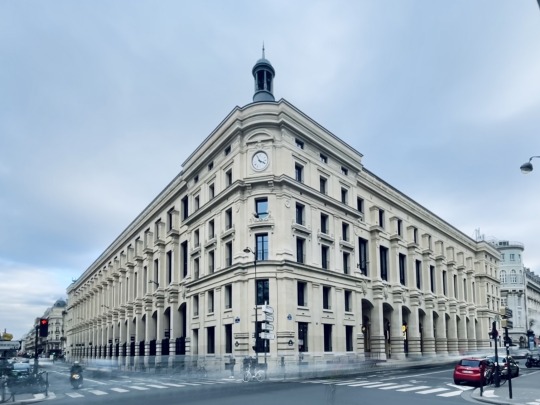
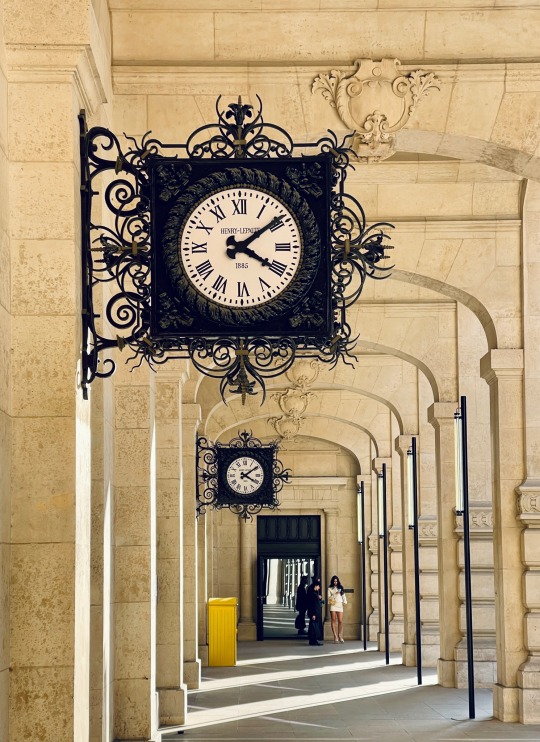

.
Wednesday Wanderings and Wonderings - Walking Distance from our Domicile.
La Poste du Louvre
La Poste du Louvre is the most emblematic site of La Poste and the most well-known to the general public. It’s the only one opened 7 days a week, 24 hours a day (often causing mad rush around taxes seasons back in the days when a stamp from the post office would certified you did indeed post it before the deadline!) and it has long been the landmark of this Parisian neighborhood.
A major renovation project was launched with the architect Dominique Perrault to completely transform the building and open it up on all sides: around the historic post office, offices, shops, a crèche, a police station, social housing, a five-star hotel and a rooftop have been built. Since its reopening to the public in 2021, the reinvented Poste du Louvre has become a must-see place in the capital.
The project restores the original great heights and all the metal frameworks, some of which had been modified or hidden by the creation of entresols dedicated to the reception of vehicles in particular. The parking lots are now placed in the basement, where a second level has been created under the building. The restoration of the original metal structure - frameworks, capitals, porticos and vaults - highlights the structural quality of the steel construction and allows natural light to be brought into the building. Freed from the constraints of its past industrial use, the volume reappears in its large structures.
When I’m on a walk in the neighborhood I almost always walk thru the building to admire it.
2 notes
·
View notes
Video
vimeo
Askungen from Folkoperan on Vimeo.
ASKUNGEN på Folkoperan 20/9 – 26/11 2023
Trailerfoto: Oskar Hökerberg. Trailerregi: Caroline Gentele.
Upphovsmakare
Musik: Gioacchino Rossini
Libretto: Jacopo Ferretti efter en saga av Charles Perrault.
Orkesterarrangemang: Jonas Dominique
Översättning: Rikard Bergqvist
Team
Dirigent: Henrik Schaefer
Regi: Nora Nilsson
Scenografi: Julia Przedmojska
Kostym: Matilda Hyttsten
Ljus: Sofie Gynning
Mask och peruk: Therésia Frisk
Dramaturgi: Tuvalisa Rangström
Ensemble
Angelina (Askungen): Josefine Andersson
Prins Ramiro: Conny Thimander
Dandini: Sebastian Durán
Clorinda: Susanna Andersson
Tisbe: Katija Dragojevic
Don Magnifico: Peter Kajlinger
Alidoro: Sami Yousri
Tre hovmän: Joakim Larsson, Viktor Rydén och Wiktor Sundqvist
Hammarklaversolist: Daniel Beskow
Folkoperans orkester
0 notes
Text
Tower-ing Fiction #20: DC Tower 1, Extraction 2 (2023)
by Shawn Gilmore
Vienna, Austria’s DC (Donau City) Tower 1, the first of a planned pair of similar skyscrapers, was designed by French architect Dominique Perrault and completed in 2013. DC Tower 1 is 60 stories tall (220m/720’ with an antenna bringing the height to 250m) and is the tallest skyscraper in Austria, which will be joined by DC Tower 2 at 44 stories (168m/551’), both with a mix of residential and commercial space. The pair of towers, which will sit across a plaza from one another, will be situated in Vienna’s District Donaustadt, as part of Donau City, a commercial district begun in the mid-1990s.
DC Tower 1 has been well-covered by the architecture press and marks a departure from the more traditional buildings which can be found across the Danube to the west in the city’s center. As such, it stands out from other more recognizable Vienna landmarks used in recent action films and shows, like the Vienna State Opera in Mission: Impossible - Rogue Nation (dir. Christopher McQuarrie, 2015), “Bank Graf Vienna” off Michaelerplatz in Red Sparrow (dir. Francis Lawrence, 2018), the State Opera and Philharmoniker Strasse in the third season of Tom Clancy’s Jack Ryan (Amazon, 2022), and the Hotel Royal, State Opera, and Donaukanal river channel in the first season of The Recruit (Netflix, 2022). [Though The Gray Man (dir. Russo Brothers, 2022) has a sequence in Vienna, that portion was filmed in Prague.] Notably, DC Tower 1 is the setting of an extended second-act action set piece in Extraction 2 (dir. Sam Hargrave, 2023), making extensive use of the tower’s façade and roof, with some digital modifications and filming in apartment and rooftop sets.
Giving a sense of the distinctiveness of the towers, promotional materials from Perrault describe the pair:
The design was conceived as two pieces of a giant monolith that split into unequal halves and open to create undulating, shimmering surfaces where the rupture occurred. While the façade of the completed building features a straightforward design on three sides, one of the larger faces is marked by folded glass planes that appear to weave in and out along the length of the tower. “The idea was to create a very specific urban space with a piazza between the two buildings,” explains Perrault. “While one face of the tower refers to the broken monolith, it is also meant to be a liquid façade evoking the surface of the river. With the second tower, they will act as waterfalls on two sides of the public space, and will be an amazing entrance gate for the district farther inland.”
The resulting monolith, set among comparatively lower-slung commercial and residential buildings, thus has a distinctive profile, especially as presented in Extraction 2.
The second act of the film opens with an establishing shot following vehicles over the Reichsbrücke (with St. Francis of Assisi Church in the foreground), as characters speed into Donau City.
A series of ground-level establishing shots give a sense of the various roadways leading to entrances and parking structures (to be used later as the action progresses).
While above, the film’s main characters move around an apartment (on the 25th floor) with a balcony to the south and walls of windows on the south and west, giving views of the Danube and surrounding geography.
These perspectives stitch together sets and argumentation of the actual DC Tower 1, which does not have southern balconies, allowing the film’s protagonist, Tyler Rake, to survey the streets below and airspace to the south—the locations of the upcoming assault.
Compare, for example, the building’s real south façade with the film’s version during the helicopter attack that initiates the action.
The attack begins with a helicopter approaching from the south, giving a view west into the central districts of Vienna.
The helicopter fires on the 25th-floor apartment, forcing the team to exit, with some members moving through the tower toward the roof.
Others begin trying to get street level, where attackers prepare a ground-level assault, assembling in the various plazas and streets around the base of DC Tower 1
Compare these with the towers’ site plan, with streets that branch off the Reichsbrücke (on the right/north side of the plan), leaving wide plazas for pedestrians and vehicles. In the film, attackers cover the entrance/exit to the DC Tower 1 parking garage and take up positions on the small northern extension that contains shops, covering the northern area with RPGs.
These shots establish the locations of the attacking force, while also giving a sense of the difficulties Rake and his team will encounter as they try to escape on the ground.
Meanwhile, a portion of the team attempts to secure the roof of DC Tower 1, potentially commandeering the attacker’s helicopter.
The rooftop scenes, while mostly congruent with the real building’s upper floors, were shot against blue screen, due to the difficulty of filming in high wind.
As the ground attempts to find a path away from DC Tower 1, they encounter the various assailants who had taken up positions near loading areas in the building’s parking garage.
The RPG teams attack police as they arrive, fending them off on both sides of the building.
As the battle spills out to the surrounding areas, the attacking teams suppress multiple forces, including Rake’s team and more militarized police, with the RPG team stationed at the base of DC Tower 1 (bottom right) and various teams on the ground.
Rake is driven back inside, moving past one of the building’s most distinctive interior features—a polished spiral staircase—part of the multi-story Meliá Vienna hotel, that winds its way up past the Level 57 lounge and restaurant.
Back near the roof, attempting to reconvene with his team, Rake fights through a gymnasium, allowing him to see a fight on the building’s awning that he will soon join.
The last stage of the assault continues out onto a glass awning, seemingly entirely constructed for the film.
The actual rooftop of DC Tower 1 is mostly surrounded by open spaces and glass walls, continuing the vertical surfaces of the floors below.
The awning fight allows for sweeping shoots of the streets below and south from Donau City.
Also filmed against blue screen, this portion of the sequence demonstrates the precarity of Rake’s position, as the glass awning shatters, leaving him and his partner, Nik Khan dangling precariously.
For some behind-the-scenes production footage of this fight, see around 7:25 here:
Rake flings Khan back into the gym, pulling himself into the final segment of the setpiece, a hand-to-hand fight seemingly suspended over the cityscape south of the tower.
Rake and Kahn rejoin the remainder of his team and leave via helicopter, closing the scene, leaving the film’s villain high above the chaos of the destruction caused by his attack, recalling Caspar David Friedrich’s Wanderer above the Sea of Fog (1818).
Weaving together the real geography and elements of DC Tower 1 with some practical and digital trickery, this act of Extraction 2 masterfully explores one of the more interesting newer architectural spaces in Vienna. Throughout, the chaotic violence is juxtaposed against the hard lines and refined spaces of DC Tower 1, creating interesting collisions.
0 notes
Text
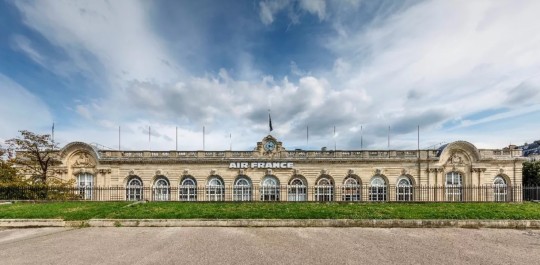
MARDI 15 NOVEMBRE 2022 (Billet 3 / 4)
SCOOP : En 2026, LE MUSEE GIACOMETTI va s'ancrer aux Invalides.
Ce lieu dédié au sculpteur, peintre et graphiste moderniste se déploiera dans le bâtiment d'Air France sur l'Esplanade, entièrement réimaginé par l'architecte Dominique Perrault.
C'est à la fois un secret bien gardé et un projet qui implique tant de pointures que Tout-Paris en parle déjà à voix basse. Un vrai musée Giacometti au cœur de la capitale ! Mieux, au cœur de l'Esplanade des Invalides, lieu de promenade par excellence, presque en face du Pont Alexandre III, il regardera le Grand Palais, promis restauré pour l'automne 2024, et le Petit Palais. Un emplacement connu de tous les Parisiens et traversé par tous les touristes. Il n'y a pas de Musée Giacometti dans le monde, le projet chinois qui doit associer Giacometti et Picasso ayant été repoussé pour la troisième fois, du fait du Covid. Ce sera donc le premier à voir le jour.
Le bâtiment était occupé par Air France depuis la Seconde guerre mondiale. Sa concession s'arrête en 2022. Il représente une surface inespérée de 1800 m2 de plain-pied au cœur des pelouses et de l'espace ouvert dans la ville, plus un étage bas et des sous-sols, soit un total de 6000 m2.
C'est un projet capital qui a dû convaincre autant l'Hôtel de Ville d'Anne Hidalgo que la Mairie du VIIe arrondissement de Rachida Dati, d'où des mois de négociations délicates et discrètes pour arriver à une entente cordiale. Air France étant parti, les travaux de démolition et de nettoyage se feront en 2023. Pas de travaux en 2024 car Paris ne pensera qu'aux JO. La construction et les aménagements muséaux commenceront après, essentiellement en 2025, pour une ouverture en 2026. La partie du bâtiment avec ses fenêtres qui s'ouvrent sur la lumière de Paris, essentielle pour la sculpture, sera consacrée uniquement à Giacometti (près de 1000m2). Une galerie sur cour, plus petite (800m2), sera destinée aux expositions thématiques.
La Fondation Giacometti apporte sa collection (près de 10.000 œuvres, dont la plupart ne sont actuellement pas accessibles au public) autant que son savoir-faire.
Ce nouveau lieu de l'art sera doté d'un musée présentant, enfin au large, une collection patrimoniale exceptionnelle, d'espaces d'expositions pluridisciplinaires et d'une école de création s'adressant à tous.
(Source : « lefigaro.fr »)
______________________________
La photo ci-dessous est un cadeau de notre neveu Emmanuel. Il l’a prise en N&B lorsqu’il y a eu une Exposition de sculptures modernes sur les Champs-Elysées au printemps 1996.
Nous avons bien aimé qu’il ait choisi de photographier « L’Homme qui marche » de dos, plutôt que de profil dont on connaît la silhouette par cœur.
Cette photo nous l’avons fait (*) encadrer et accrochée dans l’entrée.
(*) Règle : Immédiatement suivi d’un infinitif, le participe passé du verbe « faire » est invariable. (Source : « Projet Voltaire »)

1 note
·
View note
Photo
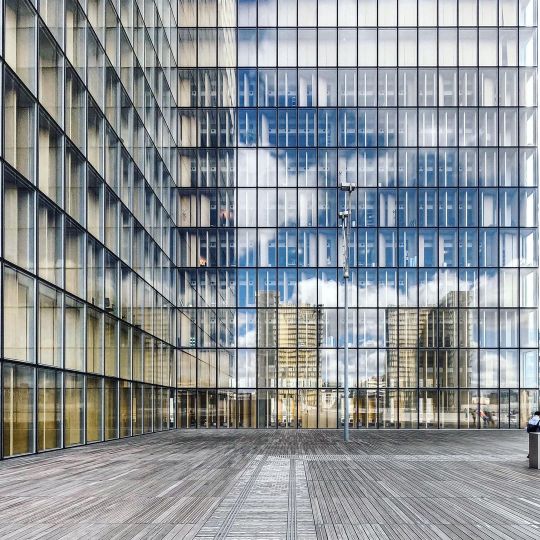
🇫🇷 Bibliothèque nationale de Francais by Dominique Perrault #paris #france #studytrip #architrcture #nobadday (at Bibliothèque nationale de France) https://www.instagram.com/p/CinDalxsXOf/?igshid=NGJjMDIxMWI=
0 notes
Photo

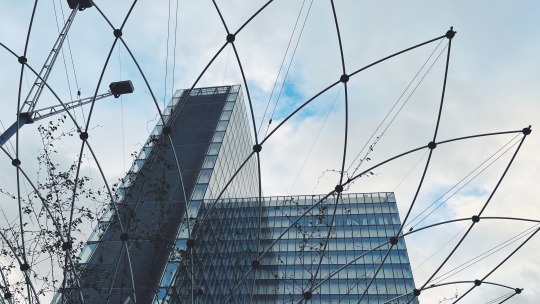
P. Paris, France - 0123 BnF François-Mitterrand
#photography#lens#camera#travel#explore#discover#scenic#scenery#looking up#facade#building#architecture#modern architecture#reflections#library#dominique perrault#paris#france
5 notes
·
View notes
Photo


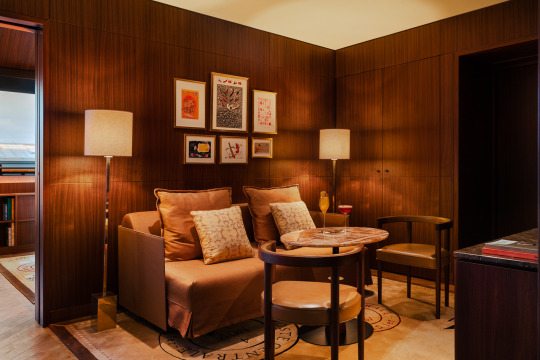

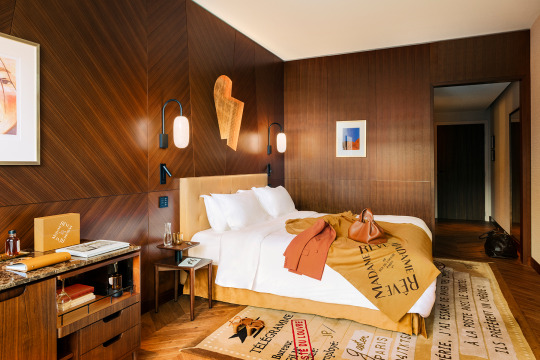
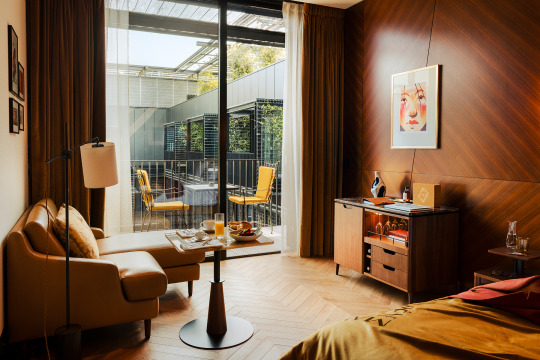

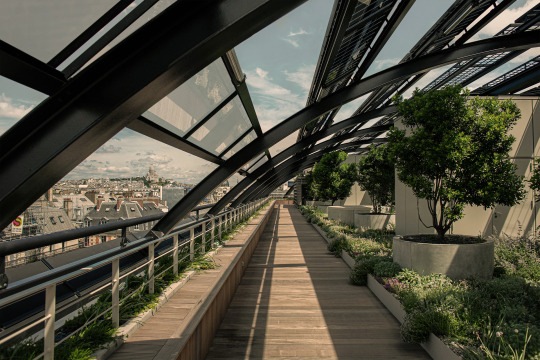

Madame Rêve, Paris, France,
Interiors: Bruno Borrione
Dominique Perrault Architects
#art#design#architecture#interiors#interiordesign#madamerêve#dream#paris#france#hotel#luxuryhotel#luxurylifestyle#travels#bruno borrione#dominique perrault#postedulouvres#boutique hotel#hotels#rooftop#gardens#eiffelparis
49 notes
·
View notes
Photo
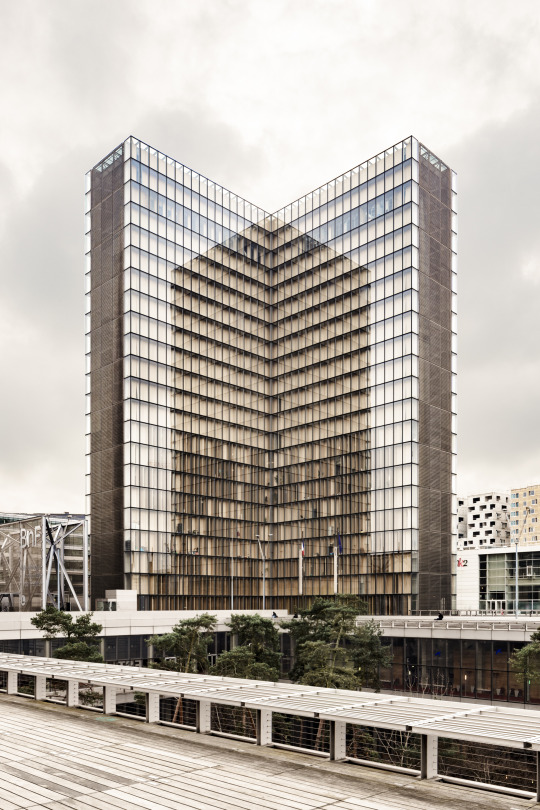
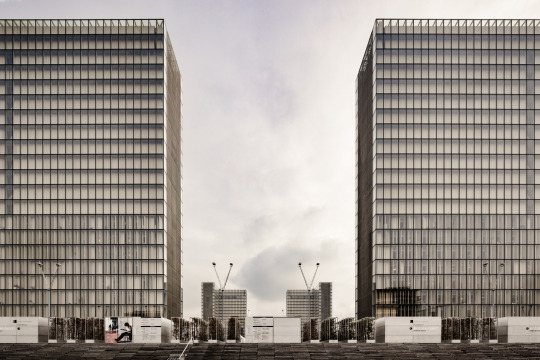
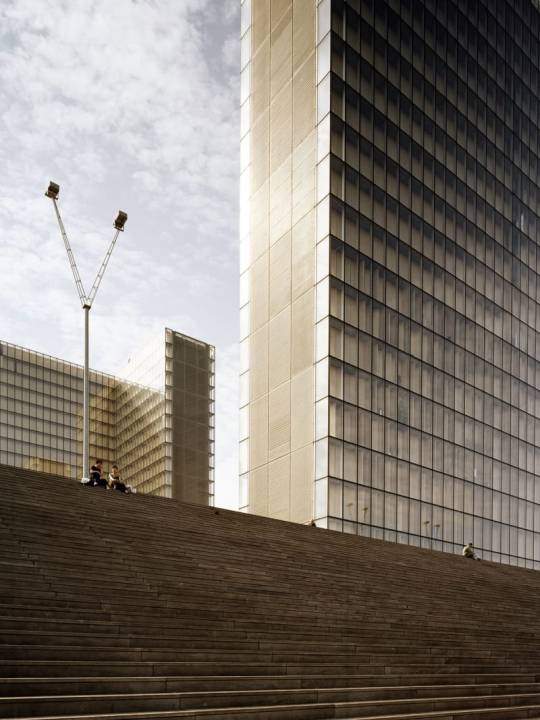
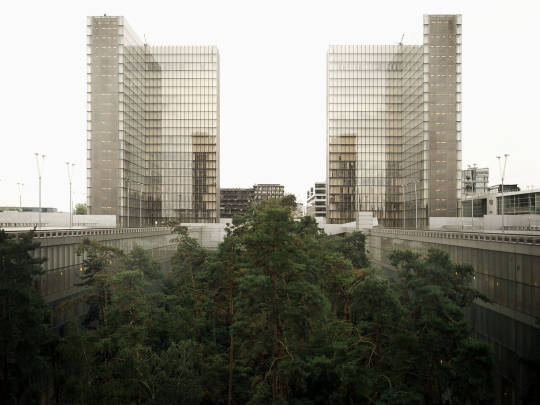
Dominique Perrault
Bibliothèque Nationale de France
Paris, France
1996
25 notes
·
View notes
Text

November 2021, Napoli - "nuova" piazza Garibaldi.
4 notes
·
View notes